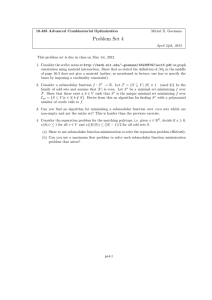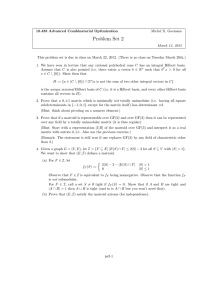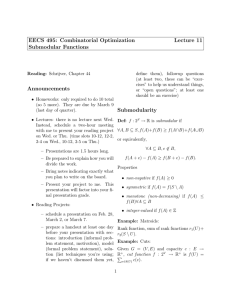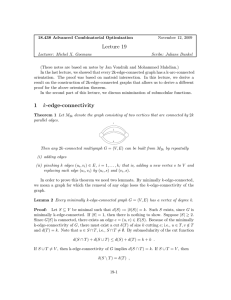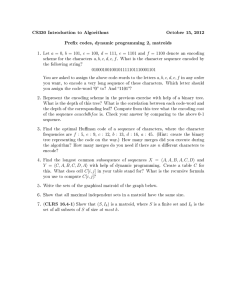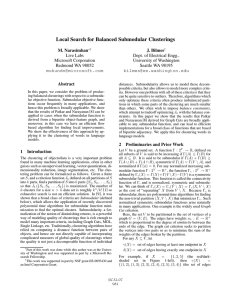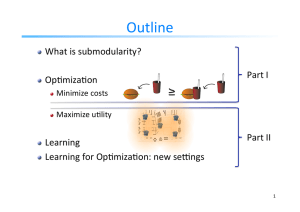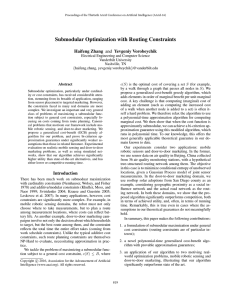Lecture 19 1
advertisement
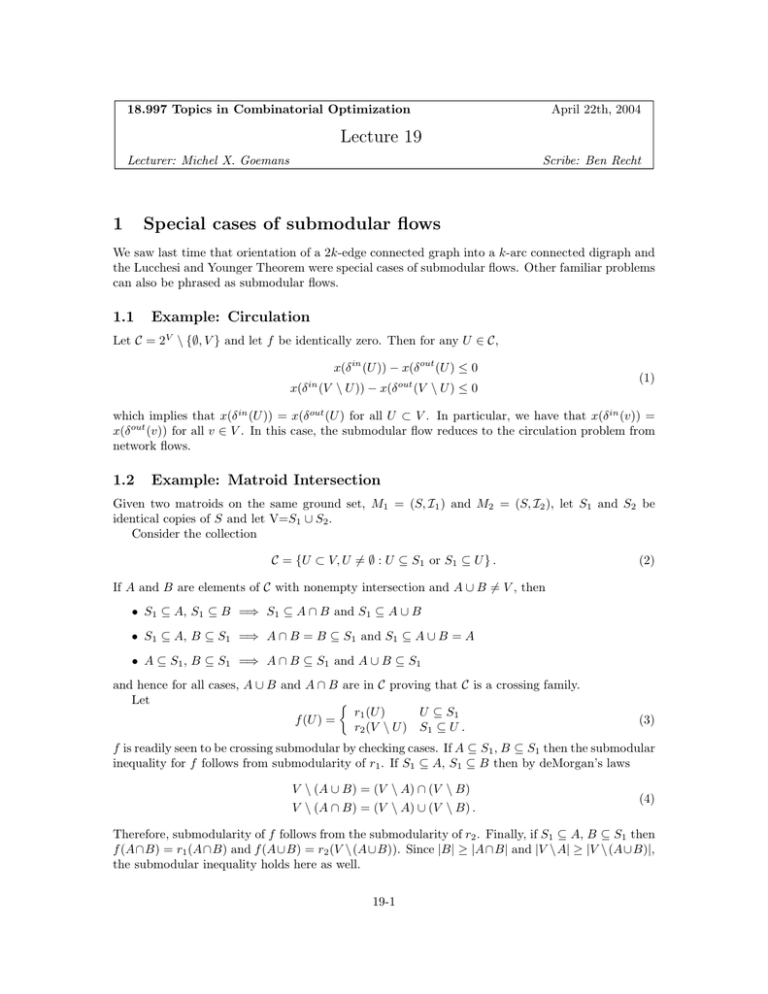
18.997 Topics in Combinatorial Optimization
April 22th, 2004
Lecture 19
Lecturer: Michel X. Goemans
1
Scribe: Ben Recht
Special cases of submodular flows
We saw last time that orientation of a 2k-edge connected graph into a k-arc connected digraph and
the Lucchesi and Younger Theorem were special cases of submodular flows. Other familiar problems
can also be phrased as submodular flows.
1.1
Example: Circulation
Let C = 2V \ {∅, V } and let f be identically zero. Then for any U ∈ C,
x(δ in (U )) − x(δ out (U ) ≤ 0
x(δ in (V \ U )) − x(δ out (V \ U ) ≤ 0
(1)
which implies that x(δ in (U )) = x(δ out (U ) for all U ⊂ V . In particular, we have that x(δ in (v)) =
x(δ out (v)) for all v ∈ V . In this case, the submodular flow reduces to the circulation problem from
network flows.
1.2
Example: Matroid Intersection
Given two matroids on the same ground set, M1 = (S, I1 ) and M2 = (S, I2 ), let S1 and S2 be
identical copies of S and let V=S1 ∪ S2 .
Consider the collection
C = {U ⊂ V, U =
∅ : U ⊆ S1 or S1 ⊆ U } .
(2)
If A and B are elements of C with nonempty intersection and A ∪ B = V , then
• S1 ⊆ A, S1 ⊆ B =⇒ S1 ⊆ A ∩ B and S1 ⊆ A ∪ B
• S1 ⊆ A, B ⊆ S1 =⇒ A ∩ B = B ⊆ S1 and S1 ⊆ A ∪ B = A
• A ⊆ S1 , B ⊆ S1 =⇒ A ∩ B ⊆ S1 and A ∪ B ⊆ S1
and hence for all cases, A ∪ B and A ∩ B are in C proving that C is a crossing family.
Let
U ⊆ S1
r1 (U )
f (U ) =
r2 (V \ U ) S1 ⊆ U .
(3)
f is readily seen to be crossing submodular by checking cases. If A ⊆ S1 , B ⊆ S1 then the submodular
inequality for f follows from submodularity of r1 . If S1 ⊆ A, S1 ⊆ B then by deMorgan’s laws
V \ (A ∪ B) = (V \ A) ∩ (V \ B)
V \ (A ∩ B) = (V \ A) ∪ (V \ B) .
(4)
Therefore, submodularity of f follows from the submodularity of r2 . Finally, if S1 ⊆ A, B ⊆ S1 then
f (A∩B) = r1 (A∩B) and f (A∪B) = r2 (V \(A∪B)). Since |B| ≥ |A∩B| and |V \A| ≥ |V \(A∪B)|,
the submodular inequality holds here as well.
19-1
To define the arc set on V , let arcs connect the elements in S2 to their bijective copy in S1 . That
is,
A = {(s2 , s1 ) : s ∈ S}
(5)
Now consider the submodular flow constraints. On this graph δ out (U ) = ∅ for all U ∈ C. If
U ⊂ S1 ,
(6)
x(U ) = x(δ in (U )) ≤ r1 (U ) .
If S1 ⊂ U , U = V \ U and hence
x(U ) = x(δ in (U )) ≤ r2 (U ) .
Putting this all together, we find that the submodular flow polytope is defined by
⎧
⎫
⎨ x(U ) ≤ r1 (U ) ∀ U ⊂ S ⎬
x(U ) ≤ r2 (U ) ∀ U ⊂ S
⎩
⎭
∀s ∈ S
xs ≥ 0
(7)
(8)
which is the matroid intersection polytope.
We will see shortly that the proof of the Edmonds and Giles theorem will use similar techniques
as those presented in the proof of the total dual integrality of the matroid intersection polytope.
2
Proof of Edmonds and Giles Theorem
We will prove the Edmonds and Giles theorem by showing that the optimal solution is defined by a
totally unimodular system of equations. Here the particular notion we will exploit is
Definition 1 A set F ⊆ 2V is cross-free if for any F1 , F2 in F, either F1 ⊆ F2 , F2 ⊆ F1 , F1 ∩F2 = ∅
or F1 ∪ F2 = V .
We can now proceed to prove the following
Theorem 1 (Edmonds-Giles) Let C be a crossing family on V , let f : C → R be crossing submodular, then the polytope
x(δ in (U )) − x(δ out (U )) ≤ f (U ) ∀ U ∈ C
(9)
da ≤ xa ≤ ca
∀a ∈ A
is totally dual integral.
Proof:
Take w to be an integral vector and consider the linear program
max
a wa xa
s.t. x(δ in (U )) − x(δ out (U )) ≤ f (U ) ∀ U ∈ C
da ≤ xa ≤ ca
∀ a ∈ A.
The associated dual problem is
min U ∈C f (U )y
U −
a da sa +
a c a ta
s.t
y
−
y
−
s
+
t
= wa
U
U
a
a
U
U
u∈U
v∈U
u∈U
v
∈U
∀ a = (u, v) ∈ A
(10)
(11)
yU ≥ 0, sa ≥ 0 ta ≥ 0.
We will now construct an optimum dual solution such that the set F = {U : yU > 0} is cross-free.
Suppose there are sets F1 and F2 in F such that F1 ⊆ F2 , F2 ⊆
F1 , F1 ∩ F2 =
∅ and F1 ∪ F2 =
V.
19-2
Let = min{yA , yB } and define a new
⎧
⎨ yT − yT + yT =
⎩
yT
dual vector y as
T = F1 or T = F2
T = F1 ∩ F2 or T = F1 ∪ F2
otherwise
(12)
y is readily seen to be feasible as any decrease in the value of yF1 or yF2 is matched by an increase
in the value of yF1 ∪F2 and yF1 ∩F2 . Furthermore, y is optimal as
c(y ) = c(y) − [f (F1 ) + f (F2 ) − f (F1 ∩ F2 ) − f (F1 ∪ F2 )] ≤ c(y)
(13)
We can repeat this process of eliminating crosses until we are left with a cross free family. The
process terminates because if we consider the potential function
(14)
yU |U ||V \ U |
ψ(y) =
U ∈C
then ψ(y ) ≤ ψ(y).
It suffices to show that the matrix defined by
yU −
U :u∈U,v∈U
yU
U ∈F
(15)
U :u∈U,v∈U
is totally unimodular when F is cross-free. This follows from
Theorem 2 Let F be a cross-free family on 2V . Let M be an |A| × |F | matrix such that column f
in
out
is the vector χδ (U ) − χδ (U ) . Then M is totally unimodular.
which is proved in chapter 13 of Shrijver and follows from an inductive argument similar to the one
presented for matroid intersection.
�
3
Algorithms for submodular flows
Knowing that the submodular flow polytope is totally dual integral does not explicitly tell us how
to optimize over it. However, optimization can be performed in polynomial time using submodular
function minimization. Given an x ∈ R|V | the function
f (U ) − x(δ in (U )) + x(δ out (U ))
(16)
is submodular on C. This is because
g(U ) = −x(δ in (U )) + x(δ out (U ))
(17)
x(δ in (A)) + x(δ in (B)) = x(δ in (A ∩ B)) + x(δ in (A ∪ B)).
(18)
is modular. Indeed, for A, B ⊂ V
and similar equality holds for δ out . Since minimizing a submodular function can be performed in
polynomial time, we can compute
min f (U ) − x(δ in (U )) + x(δ out (U ))
U ∈C
(19)
efficiently. This provides the minimal violated constraint which we can use to construct a separating
hyperplane and run the the ellipsoid algorithm.
This method is not efficient in practice, so typically submodular flows are solved via a reduction to
polymatroid intersection. Polymatroids are generalizations of matroids where the rank of a set may
be larger than the cardinality of that set. But there are special cases where even this is machinery
not necessary. One such example is orienting a 2k-edge connected graph into a k-arc connected
digraph where we only need to employ matroid intersection.
19-3
3.1
Orienting a 2k-edge connected graph
Let S denote the set of all pairs of vertices (u, v). Construct two matroids with ground set S as
follows. Let M1 be the partition matroid which allows only one of (u, v) or (v, u) to be selected.
Define the bases for M2 to be sets B ⊂ S such that |B| = |E| and for U a nonempty subset of V
which does not equal V
|B ∩ H(U )| ≤ |E(U )| + |δ(U )| − k
(20)
here H(U ) = {(u, v) ∈ S : v ∈ U }.
We assert the following to be proved next time
Proposition 3 M2 is a matroid
Proposition 4 Testing independence in M2 can be performed by network flows.
The theorem of Nash-Williams from last time shows that these two matroids have a common
basis (and the minmax relation for matroid intersection would also show it). Assuming the two
propositions, it follows immediately that we can find this basis using matroid intersection. It is
similarly immediate that a common basis for M1 and M2 is an orientation of G which is k-arc
connected.
19-4
